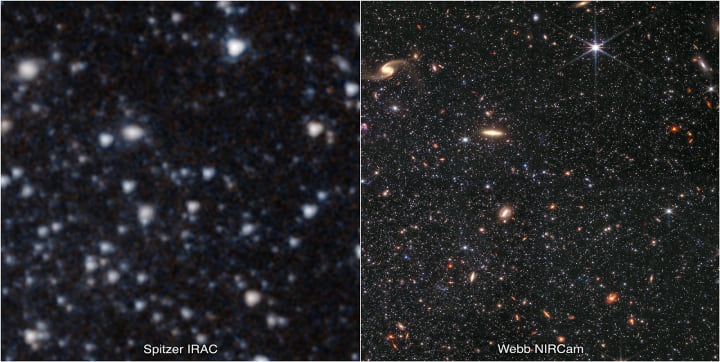Breathtaking JWST Image Unlocks New Galactic Secrets About Our Universe
The image demonstrates Webb’s remarkable ability to resolve faint stars outside the Milky Way

Since the launch of the James Webb Space Telescope in December of 2021, NASA has delivered us a plethora of incredible deep space imagery to marvel at. From nebulas to galaxy clusters, the journey for JWST has only just begun.
But one image in-particular has astronomers very excited.
The Wolf-Lundmark-Melotte galaxy (top left spiral in the image above) is a true celestial wonder. Tucked away in the vast expanse of the universe, this dwarf irregular galaxy sparkles with the light of millions of stars.
For reference, the image is about 2 arcminutes across (1,700 light-years).
Located in the constellation Cetus, just 2.7 million light-years from Earth, the WLM galaxy is a member of the Local Group, a collection of galaxies that includes our own Milky Way. Though it may be small compared to its galactic neighbours, the WLM galaxy holds its own with a diameter of around 8,000 light-years.
But size isn’t everything, and the WLM galaxy is home to some truly impressive sights. The galaxy is known for its high number of red giant stars, which are much larger and cooler than our own Sun. These brilliant beacons of light shine with a fierce intensity, adding to the beauty of the WLM galaxy.
Despite its distance from Earth, the WLM galaxy has been captured in the gaze of telescopes for centuries. It was first discovered in 1909 by astronomers Max Wolf, Markarian, and Andrew Melotte, and has been heavily studied ever since.
With each new discovery, we learn more about this fascinating corner of the universe.
Astrophysicist Insights
Kristen McQuinn, an astrophysicist from Rutgers University, told NASA that “another interesting and important thing about WLM is that its gas is similar to the gas that made up galaxies in the early universe.”
“It’s fairly unenriched, chemically speaking. That is, it’s poor in elements heavier than hydrogen and helium,” she added.
“This is because the galaxy has lost many of these elements through something we call galactic winds. Although WLM has been forming stars recently — throughout cosmic time, really — and those stars have been synthesizing new elements, some of the material gets expelled from the galaxy when the massive stars explode.”
“Supernovae can be powerful and energetic enough to push material out of small, low-mass galaxies like WLM. This makes WLM super interesting in that you can use it to study how stars form and evolve in small galaxies like those in the ancient universe.”

Galactic Features
As you explore the Wolf-Lundmark-Melotte galaxy, you might come across some of its most interesting features. For instance, the galaxy is home to a number of nebulae, glowing clouds of gas and dust that are the birthplace of new stars.
These nebulae are often brightly coloured, adding to the already stunning visual display of the WLM galaxy.
Another thing you might notice as you journey through the WLM galaxy is the presence of supernovae. These are explosions that occur when a star reaches the end of its life and collapses in on itself.
The resulting explosion is so powerful that it can outshine an entire galaxy for a short time. Observing a supernova in the WLM galaxy would be an unforgettable experience.
Despite its remote location, the WLM galaxy has a special connection to our own. Its stars and nebulae are made of the same materials as those in the Milky Way, and it is believed that both galaxies formed around the same time.
In some ways, the WLM galaxy is a reflection of our own, a reminder of the cosmic forces that shape and connect us all.
In conclusion:
So the next time you look up at the stars, take a moment to appreciate the beauty of the Wolf-Lundmark-Melotte galaxy. Whether you’re an amateur astronomer or simply someone who loves to gaze at the night sky, this distant corner of the universe has something to offer us all.
It may be far away, but it is a reminder of the infinite possibilities that exist in the cosmos.
About the Creator
CONTX Media
Innovative News & Media for Humans.






Comments
There are no comments for this story
Be the first to respond and start the conversation.